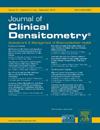Sacral Slope as an Early Marker of Postural Change in Postmenopausal Women with Low Bone Mass
IF 1.6
4区 医学
Q4 ENDOCRINOLOGY & METABOLISM
引用次数: 0
Abstract
Objectives: To assess the relationship between bone mineral density (BMD) and sagittal spinopelvic alignment in postmenopausal women with low bone mass.
Methods: Ninety-two postmenopausal women diagnosed with osteopenia or osteoporosis based on DEXA T-scores were retrospectively analyzed. Spinopelvic parameters—sacral slope (SS), pelvic tilt (PT), pelvic incidence (PI), and lumbar lordosis (LL)—were measured using lateral radiographs. Clinical and demographic variables were compared between groups using appropriate statistical methods.
Results: Among all parameters, only SS showed a statistically significant difference between osteoporotic and osteopenic women (p = 0.037). No significant correlations were found between BMD and parity, menopause age, or vitamin D levels. Osteoporotic women had lower SS values. Other spinopelvic and demographic parameters did not differ significantly between groups.
Conclusion: Alterations in SS may represent early postural and biomechanical adaptations to declining bone strength in postmenopausal women. As a determinant of sagittal alignment, SS influences pelvic orientation and lumbar curvature. Its reduction may signal a forward shift in the center of gravity, increasing fall risk. Incorporating SS evaluation into standard imaging may aid early identification of at-risk individuals. Prospective studies are needed to confirm its clinical relevance and predictive value for fractures and functional decline.
骶骨倾斜是绝经后低骨量妇女体位变化的早期标志。
目的:探讨绝经后低骨量妇女骨密度与矢状椎盂排列的关系。方法:回顾性分析92例经DEXA t评分诊断为骨质减少或骨质疏松的绝经后妇女。脊柱参数-骶骨斜率(SS),骨盆倾斜(PT),骨盆发生率(PI)和腰椎前凸(LL)-通过侧位x线片测量。采用适当的统计学方法比较两组间的临床和人口学变量。结果:在所有参数中,骨质疏松症和骨质减少症女性只有SS有统计学差异(p = 0.037)。骨密度与胎次、绝经年龄或维生素D水平之间没有显著相关性。骨质疏松女性SS值较低。其他脊柱和人口学参数在组间无显著差异。结论:SS的改变可能代表绝经后妇女骨强度下降的早期姿势和生物力学适应。作为矢状面排列的决定因素,SS影响骨盆方向和腰椎曲度。它的减少可能预示着重心向前移动,增加跌倒的风险。将SS评估纳入标准成像可能有助于早期识别高危个体。需要前瞻性研究来证实其临床相关性和对骨折和功能衰退的预测价值。
本文章由计算机程序翻译,如有差异,请以英文原文为准。
求助全文
约1分钟内获得全文
求助全文
来源期刊

Journal of Clinical Densitometry
医学-内分泌学与代谢
CiteScore
4.90
自引率
8.00%
发文量
92
审稿时长
90 days
期刊介绍:
The Journal is committed to serving ISCD''s mission - the education of heterogenous physician specialties and technologists who are involved in the clinical assessment of skeletal health. The focus of JCD is bone mass measurement, including epidemiology of bone mass, how drugs and diseases alter bone mass, new techniques and quality assurance in bone mass imaging technologies, and bone mass health/economics.
Combining high quality research and review articles with sound, practice-oriented advice, JCD meets the diverse diagnostic and management needs of radiologists, endocrinologists, nephrologists, rheumatologists, gynecologists, family physicians, internists, and technologists whose patients require diagnostic clinical densitometry for therapeutic management.
 求助内容:
求助内容: 应助结果提醒方式:
应助结果提醒方式:


